Key takeaways:
- Blockchain technology enhances security, transparency, and efficiency in the cannabis industry, allowing for better compliance and trust with customers.
- Implementing blockchain can streamline inventory management, reduce costs through smart contracts, and improve customer service with verified product journeys.
- The integration of blockchain involves assembling a knowledgeable team, selecting the right platform, and adapting existing workflows to maximize its benefits.
- Challenges such as navigating regulations and inventory management can be alleviated through the adoption of blockchain, ultimately fostering innovation and growth in dispensaries.
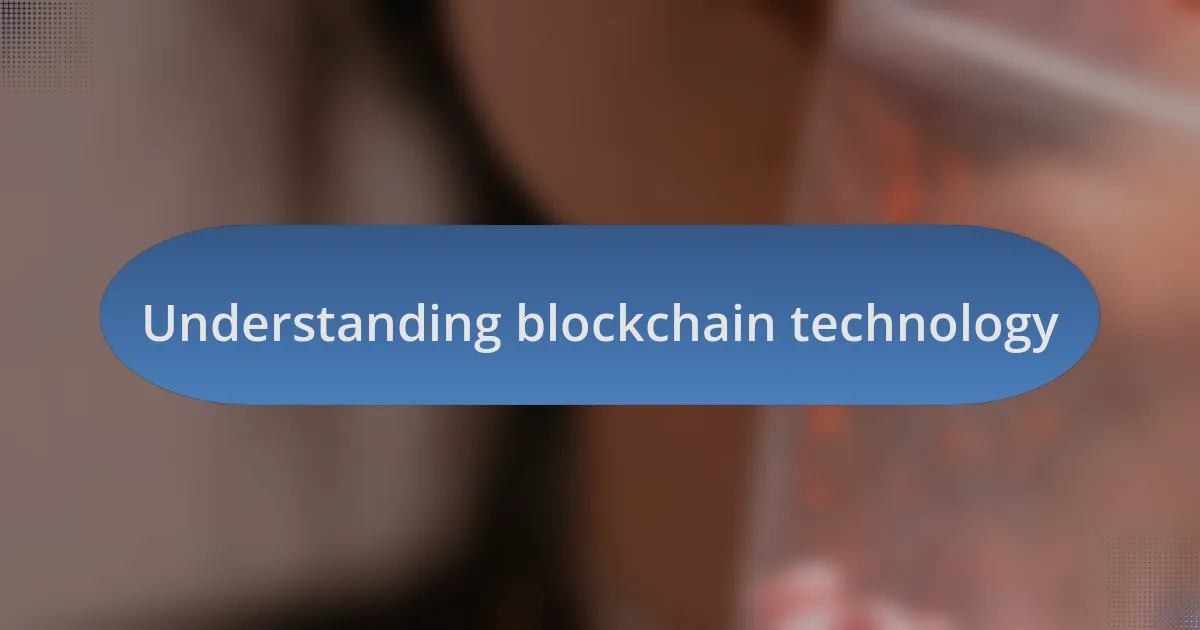
Understanding blockchain technology
Blockchain technology is fundamentally a decentralized and transparent ledger system that records transactions across multiple computers. This means that no single entity has control over the entire dataset, which I find incredibly empowering. It raises an interesting question: what would it feel like to operate in a world where trust is built into the very framework of our business transactions?
In my experience, one of the most fascinating aspects of blockchain is its security features. Each transaction is cryptographically secured and linked to the previous one, making fraud or alterations virtually impossible. When I first delved into this technology, I felt a sense of relief knowing that this level of security could protect both my business and my customers’ information. It’s a game-changer for sectors like cannabis, where compliance and transparency are paramount.
Exploring blockchain, I realized that its potential goes beyond just financial transactions. Smart contracts, which automatically execute when certain conditions are met, can streamline processes and reduce human error. Imagine being able to automate compliance checks or inventory management! Have you ever thought about how much time and energy these innovations could save in a busy dispensary like mine?

Importance of blockchain in cannabis
The incorporation of blockchain in the cannabis industry is pivotal for fostering trust among consumers and regulators alike. I recall a time when I faced skepticism from customers about the quality of our products. By implementing a blockchain system, I can now provide verifiable information about the origin and lab testing of each strain. Isn’t it comforting to know that buyers can trace their cannabis back to its source, ensuring both safety and quality?
Transparency is another critical advantage that blockchain brings to the table. Running a dispensary can often feel like navigating a labyrinth of regulations. I remember the countless hours spent ensuring our practices complied with ever-changing laws. With blockchain, not only can I easily document every step of our supply chain, but I can also effortlessly demonstrate compliance. This not only saves time but also builds a strong reputation for integrity, which is invaluable in our industry.
Lastly, the efficiency that blockchain offers cannot be overstated. I used to grapple with tedious paperwork and manual record-keeping, which often led to errors and inconsistencies. By switching to blockchain, I’ve seen operational workflows streamline remarkably. It begs the question: how much more could we accomplish in the cannabis space if we eliminated inefficiencies? I can confidently say we’ve opened the door to greater innovation and growth, and it feels empowering to be part of that change.
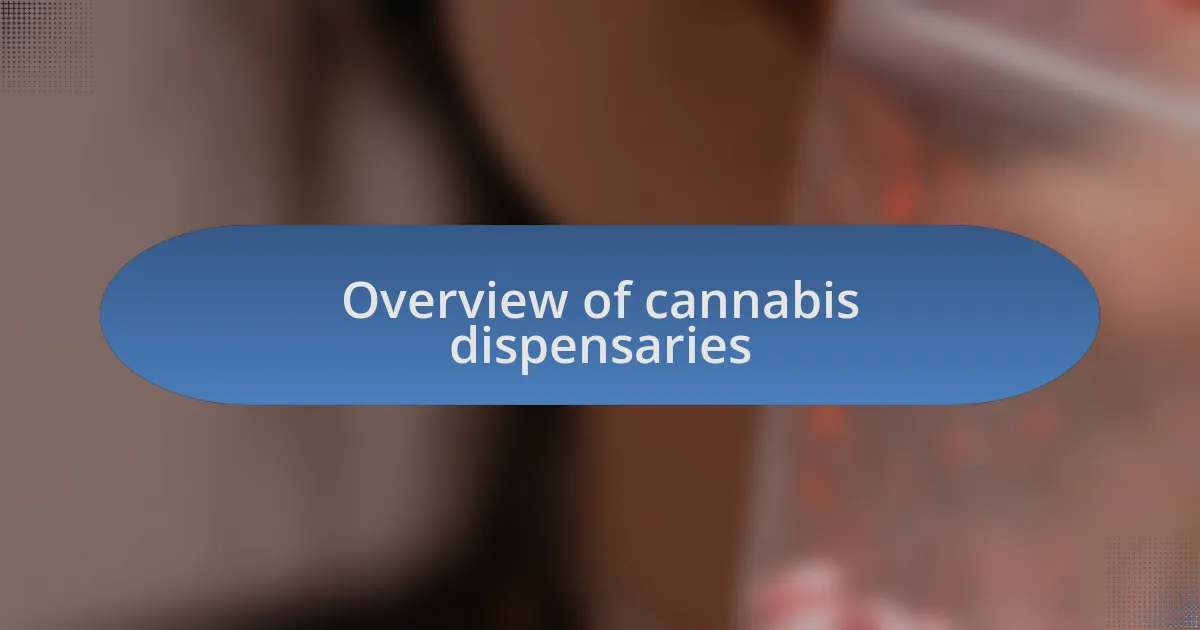
Overview of cannabis dispensaries
Cannabis dispensaries have evolved rapidly over the years, transforming from underground operations to legitimate businesses. I vividly recall the early days of legalization when customers flocked in with a mix of curiosity and uncertainty. Nowadays, dispensaries serve as community hubs, where education and quality intersect to meet the growing demand for both medical and recreational use. It makes me think—how has the perception of cannabis changed in your community?
In a typical dispensary, one can find an array of products, from flowers and edibles to oils and topicals, all aimed at catering to diverse consumer preferences. I remember the excitement the first time I stocked a range of infused beverages; it felt like we were finally breaking the mold of traditional cannabis consumption. Each product tells a story, and I strive to ensure our customers not only have access to these varied options but also understand their unique uses and benefits. Isn’t it a game-changer when customers leave feeling informed and empowered about their choices?
The experience within a dispensary goes beyond just transactions; it’s about building relationships. I often engage in conversations with patrons, listening to their needs and sharing insights based on their experiences. Ultimately, I believe a successful dispensary fosters a sense of community, where trust, education, and passion for cannabis come together. Isn’t that what we all want from our local establishments?
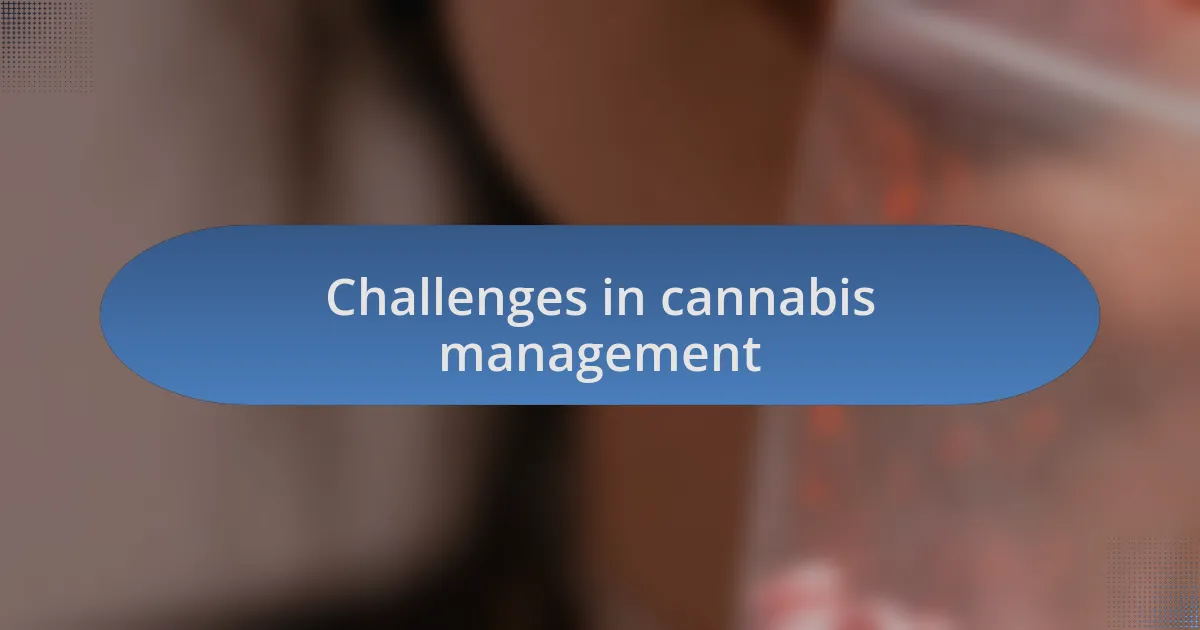
Challenges in cannabis management
Managing a cannabis dispensary presents unique challenges that can be both daunting and rewarding. One particularly difficult issue I’ve faced is navigating the complex web of regulations. Each state has its own rules, and keeping up with them can feel like a full-time job. I remember a time when a change in local licensing requirements had me scrambling to adjust our inventory and staff protocols almost overnight. Have you experienced the chaos that comes with sudden regulatory shifts?
Another huge hurdle is inventory management. With a diverse product range and an ever-evolving menu, ensuring that we have the right items on hand is no small feat. I once miscalculated a stock order for our edibles during a peak sales season, resulting in disappointed customers and lost sales. It’s a tough lesson in the importance of precise forecasting. How do others in the industry balance supply and demand without breaking a sweat?
Lastly, maintaining a skilled staff is critical, yet challenging. The cannabis industry requires knowledgeable employees who can guide customers wisely. I’ve had days where I felt overwhelmed by the need for continuous training sessions, especially as product lines change so frequently. How do dispensaries ensure their staff is both informed and passionate about cannabis education? It’s a continuous learning journey, but I believe it’s essential for providing the best service possible.

Benefits of blockchain for dispensaries
Implementing blockchain in my dispensary has significantly enhanced transparency. I vividly remember a moment when a customer questioned the source of our CBD products. With blockchain, I could instantly verify and share the entire supply chain journey, building trust that I simply couldn’t before. Have you ever faced skepticism from customers? Knowing that blockchain allows you to address that head-on can be a game changer.
Another compelling benefit has been the improvement in inventory management. By using blockchain, every transaction and product movement is recorded securely and accessibly. I recall a period where our sales skyrocketed, and my manual tracking method just didn’t cut it. The panic of not knowing our real-time inventory numbers was overwhelming. Now, I can confidently manage stock levels and avoid those costly missteps.
Cost reductions are also a major advantage I’ve noticed. With smart contracts, many processes that previously required multiple intermediaries can be automated. I remember the expenses piling up for compliance checks and payments; the savings now allow me to reinvest in quality products and staff training. Isn’t it refreshing to see how technology can directly impact your bottom line in a positive way?
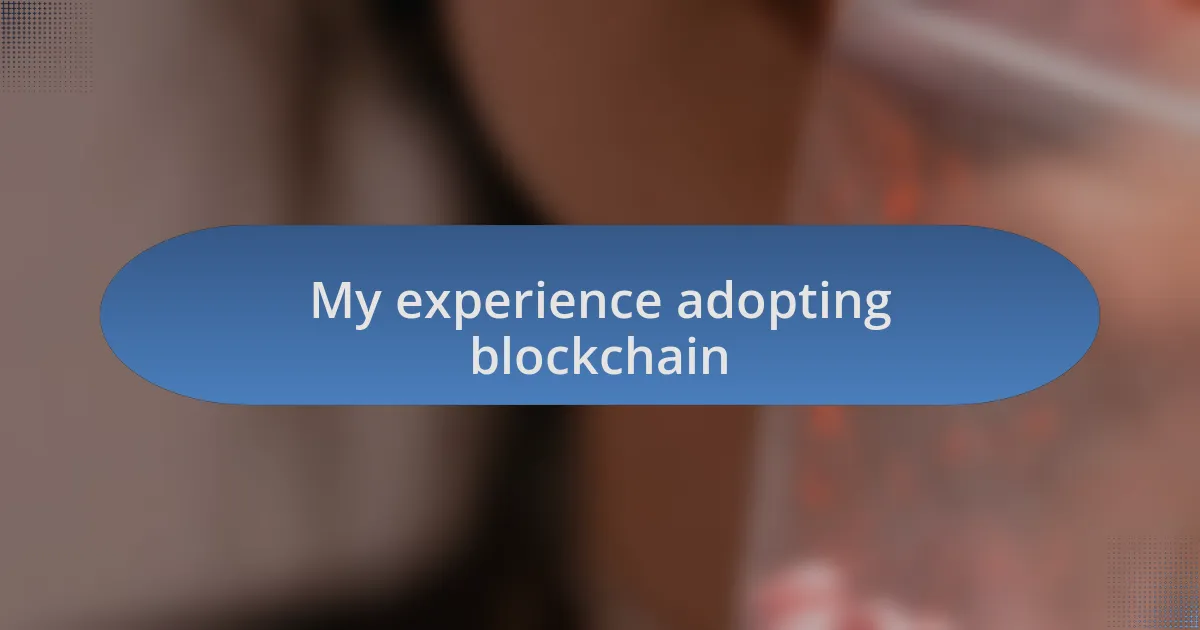
My experience adopting blockchain
Adopting blockchain in my dispensary was a journey filled with both challenges and rewards. Initially, I felt overwhelmed by the technical aspects of the technology. I remember sitting down with my team, all of us staring at a screen full of jargon and graphs, wondering if we were ready for such a change. But, as we educated ourselves, the clarity of purpose became apparent: we were investing in a system that could ultimately enhance our customer service.
There was a palpable shift in how we operated once we integrated blockchain. The first time a customer left with a complete digital record of their product’s journey was a breakthrough for us. Seeing their eyes light up as I walked them through the verification process—how reassuring it felt for them to see the integrity behind their purchase! It cemented my belief that transparency not only fosters trust but can also create a meaningful connection with our clientele. Have you ever experienced that moment when you realize the true impact of a decision? For me, this was it.
Moreover, the adaptability required for implementation taught me invaluable lessons in resilience. I remember a frustrating moment when our system encountered an unexpected glitch during a busy sale day. While my first instinct was to panic, it became an opportunity to dig deeper into our setup. Through that experience, I learned that embracing technology means accepting the bumps along the way. It’s part of the growth process. Isn’t it refreshing to realize that every challenge can lead to greater understanding?
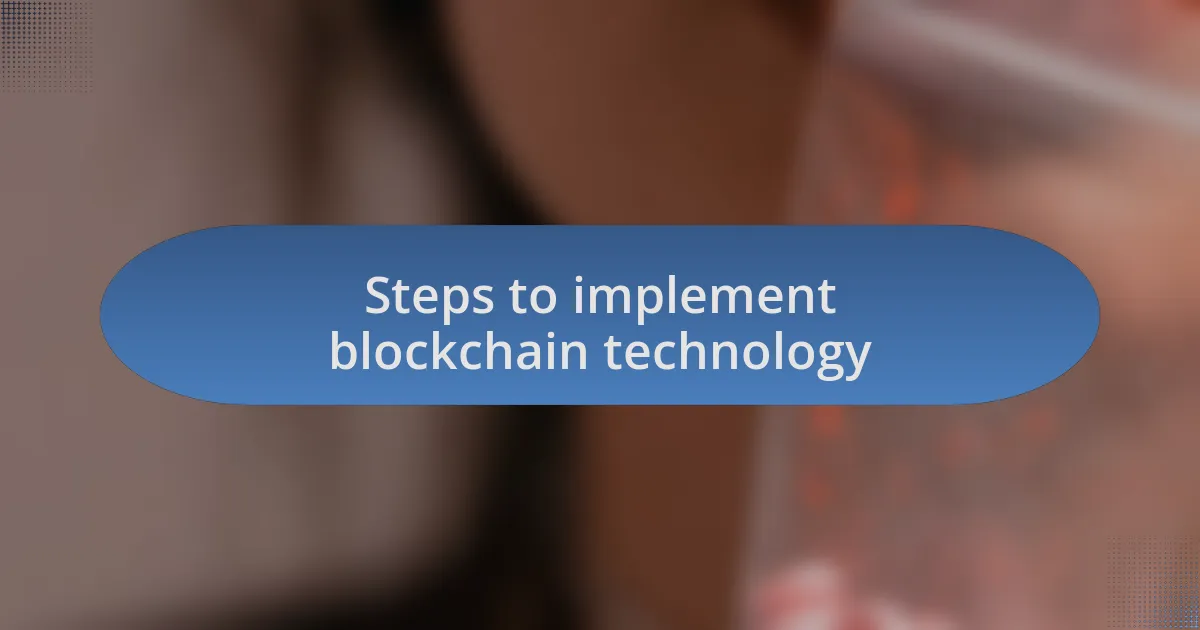
Steps to implement blockchain technology
To start implementing blockchain technology, I found it crucial to assemble a knowledgeable team. This meant collaborating with tech-savvy individuals who could break down complex ideas into digestible components. I remember having team brainstorming sessions where we collectively mapped out our goals. From figuring out what data we wanted to track to exploring potential software solutions, this foundational step helped us align our vision.
Once we had our team in place, the next step was to select the right blockchain platform. This decision felt overwhelming at first—there are so many options! I leaned on industry contacts and conducted extensive research to compare features and usability. I can still recall the late-night phone calls with suppliers discussing everything from transaction speed to compliance with regulations. It was during these discussions that I truly appreciated how crucial this step was to ensure our system would serve both our business goals and customer needs effectively.
After choosing the platform, I focused on integrating it into our existing workflows. This required patience and a willingness to adapt. I remember the initial resistance from some staff members; change can be daunting, right? However, through hands-on training and sharing success stories from other dispensaries, we slowly built confidence. Witnessing my team get excited about the possibilities was incredibly rewarding—it turned abstract concepts into tangible benefits for our customers. Have you ever felt that shift from uncertainty to enthusiasm? It’s a powerful transformation when everyone sees their role in the bigger picture.